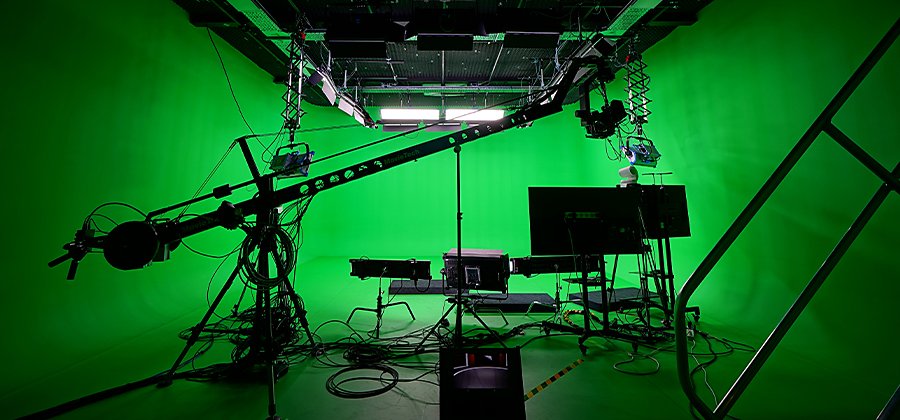Bluescreen oder Greenscreen?
Ein einfarbiger Hintergrund ist ein vielseitiges Hilfsmittel zum Erzeugen von Spezialeffekten in Filmen. Finde heraus, was für deine nächste Videoproduktion am besten geeignet ist: ein Bluescreen oder ein Greenscreen?

The color of cinema.
If you’ve ever watched a behind-the-scenes special for a Hollywood blockbuster, you’ve probably seen actors performing in front of a green or blue background. But you don’t have to be a professional filmmaker to enjoy the benefits of a blue or green screen. Even if you’re an amateur shooting a short film in your backyard or a YouTuber making a tutorial video, hanging something as simple as a green or blue sheet in the background of a shot gives you the power to add stunning VFX during the post-production process by using a technique called chroma key compositing.
“In the old days with film, blue made it easier to key things. With digital cameras, green is more popular,” says filmmaker Charles Yeager. “But even in modern films they still use blue screens for specific reasons. There are pros and cons to both.”
What is chroma key?
“Chroma key is when you lock onto a specific color that’s different from anything else in the shot and eliminate it completely,” says director and cinematographer Steven Bernstein. “Sometimes that’s green, because it gives you the best separation. But we have the video editing technology to lock onto any shade of whatever color we want.”
Blue or green colors are popular backgrounds for filmmaking because they’re different from most human skin tones, hair colors, and clothing. This is why it’s important to make sure your actors don’t wear anything that matches the color of the screen behind them. For example, if an actor wears blue clothing in front of a blue screen, their body will be chroma keyed out of the shot along with the screen behind them. This is because the chroma key process keys out and removes everything that is the same color as the background screen.


Which screen color is best?
Whether you use a blue screen or a green screen ultimately depends on the circumstances of your shoot.
Lighting
One key factor is luminance, or the amount of light a color reflects. A green background has a much higher luminosity than a blue one, making a green screen a better choice for daytime scenes when you want your shots to look bright and well lit. But a blue screen can be handy in scenes where you don’t need so much light.
“If you’re trying to composite around an actor in a night scene, you want to go with a blue screen,” Yeager recommends. “It’s darker, so it’ll reflect less light back on them, which means less color spill to deal with in post-production. Color spill is when the color of the chroma key background is reflected back onto the actor. This can make the keying process more difficult, so you want to avoid color spill as much as you can.”
Costumes and hair color
If the scene you’re shooting absolutely requires a character to wear green, you should use a blue background, and vice versa. But even colors that don’t match the background can still cause a problem. “Blond hair can be difficult to key out on a green screen because of the way light reflects through it. It’s almost a little bit translucent and you get color spill,” Yeager says. “A blue screen gives you a much stronger contrast with blond.”


Images by Charles Yeager
Environment
If you’re filming a blue or green screen in an outdoor environment, you should be as concerned with the colors of your surroundings as you are with your actors’ costumes. If you’re someplace where trees and grass will be visible in your shot, you’re better off using a blue screen. If there’s a large body of water in the scene, then green is the way to go.
Fine details
Because blue screens have lower luminance, there’s less chance of color spill around the edges of your actors. If you’re filming a shot where the actor and the chroma key background are close together, use a blue screen as it will help ensure the color spill will be much less.
Whether you’re making a sci-fi epic or a quiet indie character study, the right color of backdrop coupled with chroma key technology can unlock a new world of opportunities for your film.
Contributors
Mit Adobe Premiere Pro erfolgreicher sein
Erstelle auf praktisch jedem Gerät beeindruckende Videos – für Film, Fernsehen und das Web.
You might also be interested in…
Verschaffe dir einen Überblick über den Prozess des Filmemachens mit diesen Tipps von professionellen Filmemachern.
ASMR-Video für YouTube erstellen.
ASMR (Autonomous Sensory Meridian Response) ist eine erfolgreiche Methode zur Entspannung. Lerne, wie du ein professionelles ASMR-Video für YouTube erstellst.
Lerne den Prozess des Filmemachens vom ersten Entwurf bis zum fertigen Werk kennen.
Hole dir Adobe Premiere Pro.
Produziere hochwertigen Content mit dem Branchenstandard für professionellen Videoschnitt.
7 Tage kostenlos, danach 25,99 € pro Monat.



